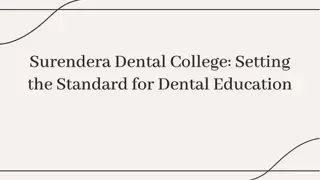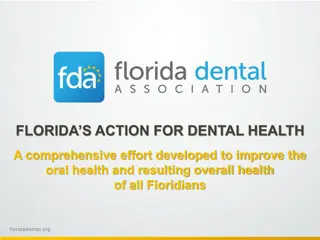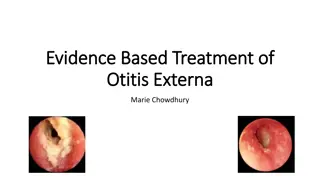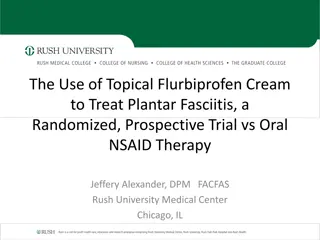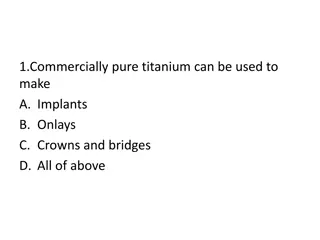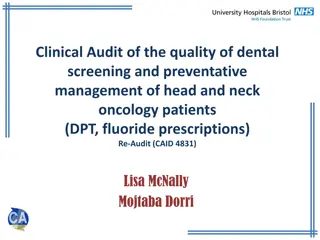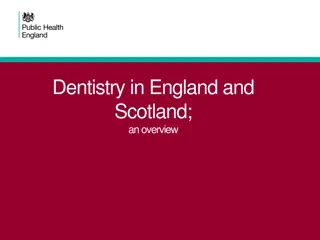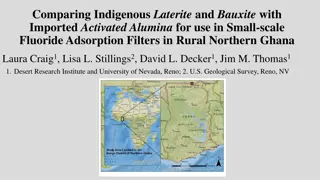Understanding Topical Fluoride Therapy for Dental Health
Topical fluorides are effective for preventing dental caries when applied locally to the tooth surface. They offer advantages like being cariostatic, safe for all ages, and easy to use. However, they require regular application and can be more costly compared to water fluoridation. The efficacy of topical fluoride depends on the concentration used, application frequency, and the specific fluoride compound. Different methods and vehicles exist to deliver therapeutic fluoride concentrations, each with varying ppm levels. Understanding the mechanisms of fluoride action helps in appreciating its role in dental health.
Download Presentation

Please find below an Image/Link to download the presentation.
The content on the website is provided AS IS for your information and personal use only. It may not be sold, licensed, or shared on other websites without obtaining consent from the author. Download presentation by click this link. If you encounter any issues during the download, it is possible that the publisher has removed the file from their server.
E N D
Presentation Transcript
Topical Fluorides Dr. Rihab Abdul Hussein Ali B.D.S , M.Sc. , PhD.
Topical fluoride Topical fluoride consider as alternative methods for the water fluoridation, and when fluoride therapy is required. The term topical fluoride therapy refers to the use of systems containing relatively large concentrations of fluoride that are applied locally or topically, to the erupted tooth surface to prevent the formation of dental caries. Application of topical fluorides immediately after eruption hastens fluoride uptake and makes enamel more resistant to dental caries.
Advantages of topical fluoride: 1. Does not cause fluorosis. 2. Cariostatic for people of all ages. 3. Available only to people who desire it. 4. Easy to use.
Disadvantages of topical fluoride: 1. Person must remember to use. 2. High cost compared to water fluoridation. 3. More concentrated professional use products can cause short-term side effects like nausea immediately after use.
The efficacy of topical fluoride depends on: a. The concentration of fluoride used. b. The frequency with which it is applied and the duration of application. c. The specific fluoride compound used.
Range of therapeutic fluoride concentrations used to prevent caries Method/vehicle Fluoride concentration (ppm F) Water supplies 0.7 1.2 ppm Fluoridated salt 200 250 ppm 0.05% NaF Mouthrinse, Once daily 230 ppm 0.2% NaF Mouthrinse, Once weekly 920 ppm Dentifrices, children 250 500 ppm Dentifrices, adult Twice daily 1,000 1,500 ppm 1.1% NaF gels Once daily 5,000 ppm Professionally applied solutions (2% NaF) 9,200 ppm Professionally applied solutions, 12,300 ppm gels, foams (1.23% APF) ppm Professionally applied solutions (8% SnF2) 19,500 ppm Professionally applied varnishes (5% NaF) 22,600 ppm
Mechanisms of Fluoride Action: Scientists have proposed that fluoride has several functions 1. Increased enamel resistance or reducing enamel solubility [acid dissolution]. 2. Interferes in the formation and functioning of dental plaque microorganisms. 3. Increases the rate of post-eruptive maturation. 4. Remineralization of incipient lesions. 5. Improves tooth morphology.
The presence of elevated concentration of fluoride in enamel surface makes tooth surface more resistant to development of dental caries. Fluoride ions when substituted into the hydroxyapatite crystals fit more perfectly than do hydroxyl ions. Also the greater bonding potential of fluoride makes the apatite crystals more compact and more stable, thereby more resistant to the acid dissolution. When concentrated topical fluoride agent reacts with enamel there is formation of calcium fluoride: Ca10[PO4]6[OH]2+20F 10CaF2+6[HPO4-]3 +2[OH]-
Most topical fluoride agents have a fluoride ion concentration of between 10,000 20,000 ppm which leads to the formation of calcium fluoride and eventually Fluorhydroxyapatite. Fig (1) Mechanism of action of fluoride on enamel
Commonly used topical fluoride agents include Sodium fluoride, Sodium monofluorophosphate, Stannous fluoride and Amine fluoride. Fig (2) various types of fluoride
Fluorides effect on tooth mineral: Fluoride, however, substituting for the hydroxyl group fits extremely well and stabilizes the hydroxyapatite (HA) molecule forming fluoridated apatite fluorapatite (FA). If all of the hydroxyl ions are substituted fluorapatite (FA) forms. The fluoride ion is extremely electronegative and forms very strong hydrogenbonds with hydroxyl and acid phosphate groups in the HA crystal rendering the enamel surface more difficult to protonate. Essentially this makes the enamel more difficult to demineralize, and it also favors the remineralization process.
This is the primary chemical mechanism of fluoride s action to protect the tooth against acids produced by plaque metabolism. Fluoridated apatite and/or fluorapatite are generally found in the surface layers of enamel that contains high concentrations of fluoride. This can arise both during development and from topical exposure.
1-Decreases the solubility of the crystals The presence of elevated concentration of fluoride in enamel surface makes tooth surface more resistant to development of dental caries. Fluoride ions when substituted into the hydroxyapatite crystals fit more perfectly than do hydroxyl ions. Also the greater bonding potential of fluoride makes the apatite crystals more compact and more stable, thereby more resistant to the acid dissolution.
2- Remineralization As the saliva flows over the plaque and its components neutralize the acid, raising the pH, demineralization is stopped and reversed. The saliva is supersaturated with calcium and phosphate, which can drive mineral back into the tooth. Fluoride enhances remineralization by adsorbing to the crystal surface and attracting calcium ions, followed by phosphate ions, leading to new mineral formation. The partially demineralized crystal surfaces within the lesion act as nucleators , and new surfaces grow on the crystals.
These processes constitute remineralizationthe replacement of mineral in the partially demineralized regions of the carious lesion of enamel or dentine (including the tooth root). FAP contains approximately 30,000 ppm F and has a very low solubility in acid.
Increased Enamel Resistant: The topical effect of fluoride in reducing enamel solubility occurs during the repeated cycles of demineralization and remineralization in the early stages of carious lesion. When tooth is exposed to a pH of about 5.5 or lower enamel dissolution starts. This occurs beneath bacterial plaque. The concentration of calcium, phosphate and other ions increases in the solution. When the pH returns back to normal the dissolved minerals get precipitated. Hence, carious dissolution of enamel is a cyclic phenomenon consisting of phases of demineralization when precipitation occurs.
The presence of low levels of fluoride in the plaque leads to a gradual establishment of well-crystallized and more acid resistant apatite in enamel surface. The other mechanisms which have been postulated in rendering decreased enamel solubility are: 1-That under the influence of fluoride, larger crystals are formed with fewer imperfection thus stabilizing the lattice and presenting a smaller surface area/unit volume for dissolution.
2-Enamel which mineralizes under the influence of fluoride has a lower carbonate content thus giving a reduced solubility. (FAP = Ca10(PO4)6F2) in which the OH ion in pure hydroxyapatite is completely replaced by an F ion. The resulting mineral FAP is highly resistant to dissolution by acid.
Inhibition of Bacterial Enzyme System: Fluoride interferes with oral bacteria in two ways: In high concentrations it acts as bactericidal and in low concentration it decreases acid production. Fluoride inhibits glycolysis the process by which fermentable carbohydrates are metabolized by cariogenic bacteria to produce acids. Plaque fluoride can inhibit the production of extracellular polysaccharides by cariogenic bacteria this is necessary for plaque adherence to smooth enamel surfaces. Fluoride can interfere with enolase, an enzyme which is used by bacteria in the fermentation of carbohydrates.
Topical Fluoride administration could be applied through. 1. Those applied by professional. a. Topical solutions and gels. b. Fluoride containing varnishes. c. Fluoride prophylaxis paste. d. Restorative materials containing fluoride. e. Fluoride containing devices (Slow Release). 2. Self applied fluoride agents. a. Fluoride dentifrices. b. Fluoride rinses. c. Fluoride gels.
Classification of Topical Fluoride: Fluorides Applied by Dentist/Professionally Applied A. Aqueous solutions 1- Sodium fluoride - 2 % 2- Stannous fluoride - 8% B. Fluoride Gels 1- Acidulated phosphate fluoride - 1.23 % C. Fluoride varnishes 1- Duraphat 2- Fluorprotector D. Fluoride prophylactic paste E. Restorative materials containing fluoride (composite resin) F. Fluoride containing devices (slow release)
Self-Applied 1- Fluoride dentifrices. 2- Fluoride mouth rinses. 3- Fluoride gels. Fluoride Compounds 1- Inorganic compounds (e.g. Sodium fluoride (NaF)) Readily soluble salts that provide free fluoride; the most commonly used fluoride compound (both self application and professional use); when in solution, NaF salt readily releases fluoride into saliva, dental plaque, pellicle and enamel crystallites. Used in dentifrices , mouth rinses, chewing- gums, solutions , gels ,varnishes ,prophylaxis pastes, slow- release devices
Ammonium fluoride (NH4F) although investigated intensively some decades ago, it is currently unused mainly due to its unpleasant taste and lack of superiority in clinical performance over NaF formulations used in solutions Titanium tetrafluoride (TiF4) able to significantly reduce enamel solubility (as solution), due to the formation of a glaze on enamel and dentine; currently being tested in solutions/varnishes as preventative for caries and erosion used: solutions, varnishes
2 -Monofluorophosphate-containing compounds: fluoride is covalently bound to PO3 2 ions and requires hydrolysis to release fluoride ions; e.g. dentifrices (neutral pH) gels (neutral and acidic pH) (Na2FPO3) one of the main advantages is its compatibility with abrasives. 3- Organic fluorides: fluoride bound to organic compounds. e.g. Amine fluoride which used in dentifrices, gels, mouth rinses , prophylaxis pastes, associated with a reduction in plaque adhesiveness due to the greater affinity of hydrophilic counter- ions to the enamel.
Goals of Fluoride (F) Administration 1. Do not harm the patient. 2. Prevent decay on intact dental surfaces. 3. Arrest active decay. 4. Remineralize decalcified tooth surfaces. Fig (4). Goals of fluoride administration









